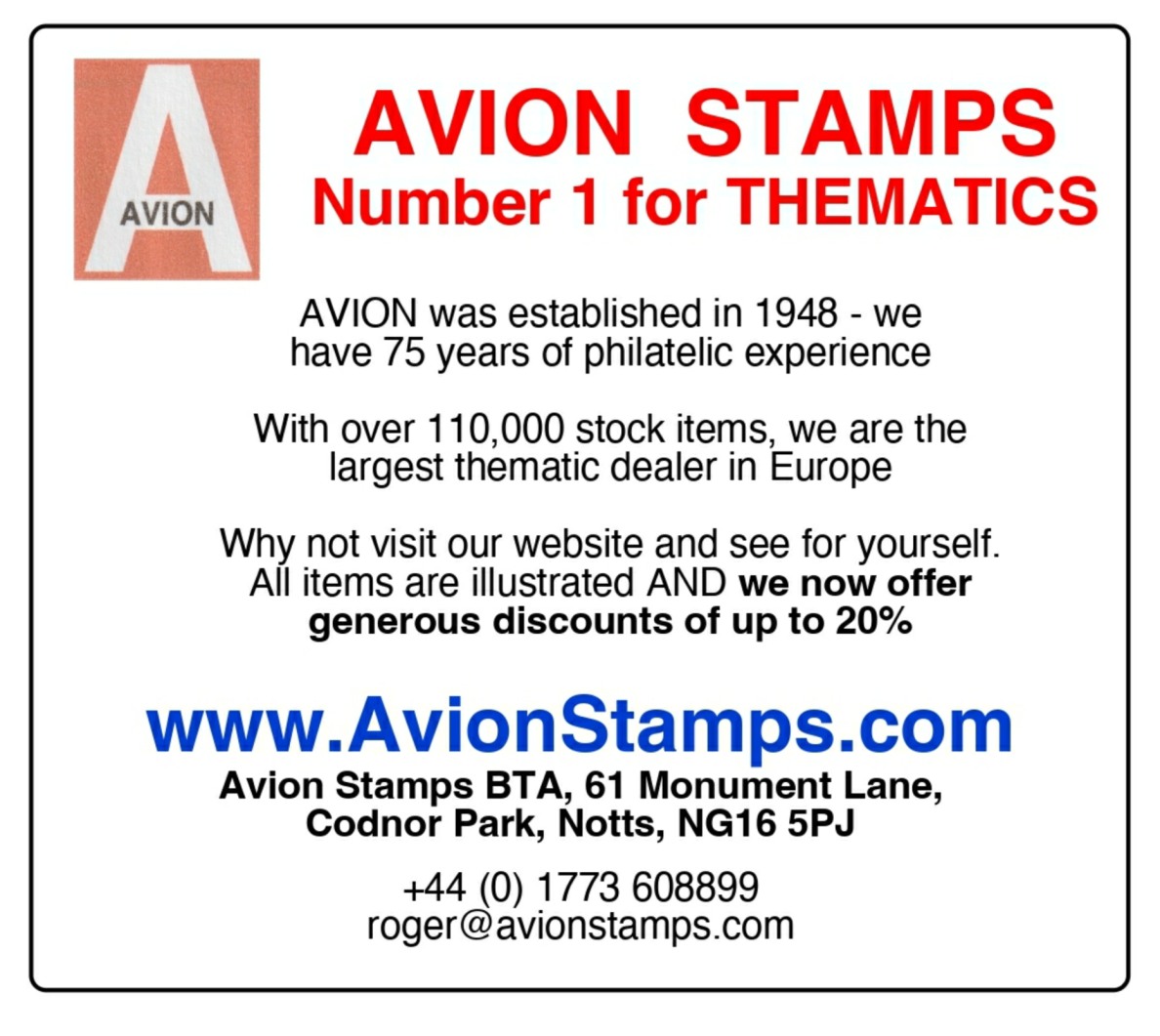Types Of Material
There are many types of material that you might consider including in your collection.
Most people, when they start collecting a particular theme, first look out for stamps depicting aspects of their subject. But after a time some choose to go further.
This list has been compiled to give you an idea of the many types of material you can include if you want to.
Materials in Courier font are excellent for a collection, and for Open exhibiting, but would not be acceptable in a thematic exhibit. It is always wise to consult the official guidelines if you are competing.
This list is designed to be indicative, it is NOT exhaustive.
THE STAMP
Elements of Stamp Production
Original drawings. Essays. Proofs. Colour trials
Issued Stamps
Normal stamps. Varieties. Errors, such as printing or perforation. Tabs (particularly Israel)
Publicity material for stamps
Post Office issued material: presentation packs, PHQ cards, Post Office publicity
Stamps issued as multiples
Booklets; not only the stamps inside them, but the front or back cover, inside front or back cover, and inter-leaved advertisements. Coils. Sheets, sheetlets and miniature sheets, which were first issued around 1930. The selvedge can be used as well as the stamps.
Stamp issues for non-standard situations
Including: Local posts. Town posts. Provisional issues. Swiss Army stamps (which were valid for general use). Strike posts. Items issued at philatelic exhibitions.
Post office issued stamps for specific purposes
Postage due; Express of Special Delivery. Parcel post. Test stamps. Training stamps
As well as the stamp itself
Backs; the back of issued stamps sometimes carried advertisements or underprints. Some stamps were printed on paper meant for other purposes, such as maps and bank-notes. Perfins; shapes can be found as well as letters. Information, including details of publications, can be found at the website of The Perfins Club
Revenue stamps
These are used to collect taxes or fees.
Examples are: Newspaper. Telegraph. Railway. Official: issued by designated government departments or similar, for their own use; there are occasional examples of these being authorised for general postal use. Specific taxed items such as tobacco, alcoholic drinks, drugs and medicines, playing cards, hunting licenses, firearm registration
The Revenue Society is dedicated to this aspect of collecting.
Cinderellas
There is some overlap here with other sections of this list. The Cinderella Stamp Club defines them as ““Local stamps, telegraph stamps, railway stamps, revenues/fiscals, forgeries, bogus and phantom issues. Christmas, Red Cross, TB and other charity seals, registration labels, advertisement and exhibition labels and many other items”.
MACHINE GENERATED POSTAGE (postage stamp issued on demand from a vending machine)
ATM (Automatic Transfer Machine) labels. Issued by many countries, particularly Germany and Spain.. Framas. Post and Go (UK, Channel Islands, Gibraltar).
POSTAL MARKINGS
Handstamps
Illustrated handstamps started in the 1920s; French and Italian are particularly prolific although it is not always easy to find out what is available. One published source for the UK is Special Event Postmarks of the United Kingdom
Meter marks
Illustrated meter marks started in the 1920s, particularly in Western Europe. A website which illustrates a range of these for the UK is UK Meter Franking. It also has links to other relevant sites.
Postal slogans
Introduced for cancelling mail in 1917 these provide a wealth of pictorial images. For the UK there is an eight-volume publication Collecting Slogan Postmarks
Postal History
Postmarks, cachets, censor marks, directional and instructional markings etc. can all be used:
- Transport. Because mail has been carried by transport it lends itself to that theme, for instance a railway theme could use TPOs or a ship theme ship letters.
- Military mail can be used for a military theme.
- Look out for postmarks of places sharing the same name as someone famous, or a particular topic, such as Bowler in Derbyshire.
POSTAL STATIONERY
Around since the 1890s these can be useful where a relevant illustration is on the card but not on a stamp. Postal stationery includes envelopes, cards, letter sheets, air letters and aerogrammes. Telegrams and greetings telegrams can fall into this category. Akin to postal stationery are postal cheques where firms paid for advertisements. Information about some of these can be found in Higgins & Gage World Postal Stationery 18 loose-leaf volumes, now badly out of date. Israel issued postal stationery cards in packs with interleaved advertisements. Since the 1980s Japan has been releasing cards colloquially known as “Echo” cards. China has issued a lot of cards since 1990, many of them having a tear-off national lottery slip.
MISCELLANEOUS
Postcards. An exhibit class in its own right
Maxicards. A ‘proper’ maxicard should contain an illustrated card, stamp and postmark, where all three are linked by theme but have different illustrations.
Banknotes and other currency such as notgeld.
Ephemera
This can include photographs, documents, maps, trade, cigarette and telephone cards, advertising labels, matchbox or cheese labels, aerial propaganda leaflets. The list is endless! The Ephemera Society defines the term as “the minor transient documents of everyday life”.
